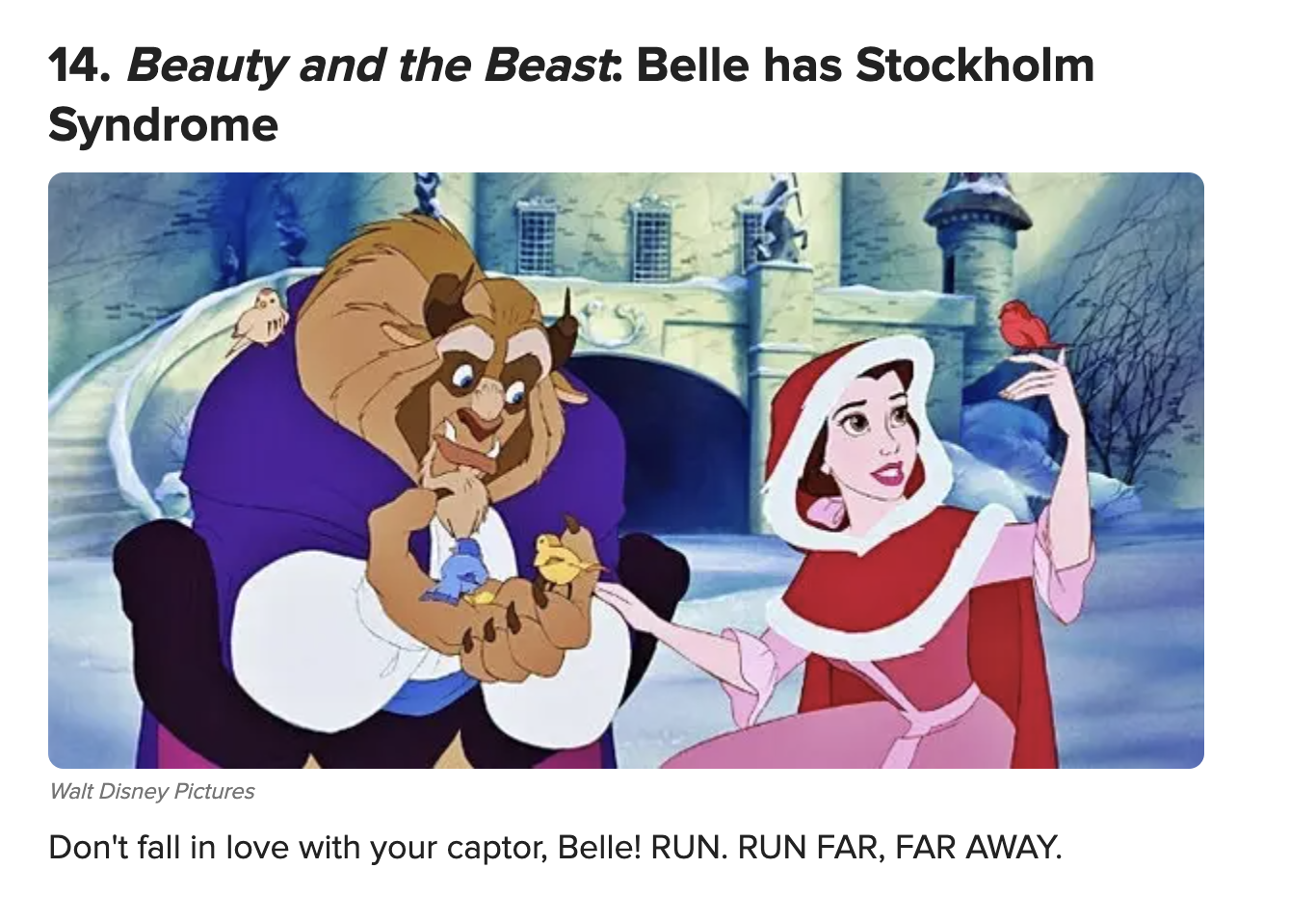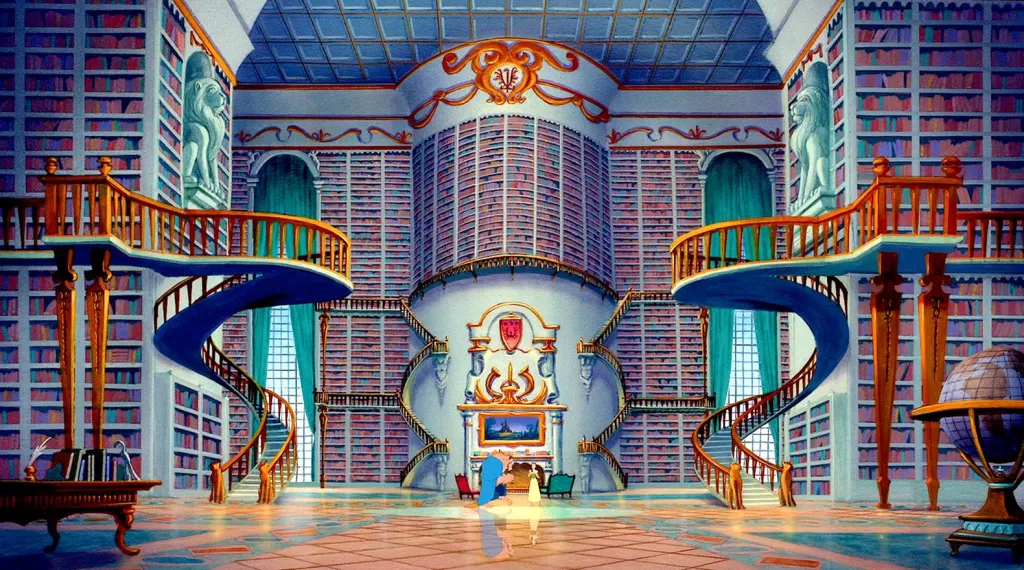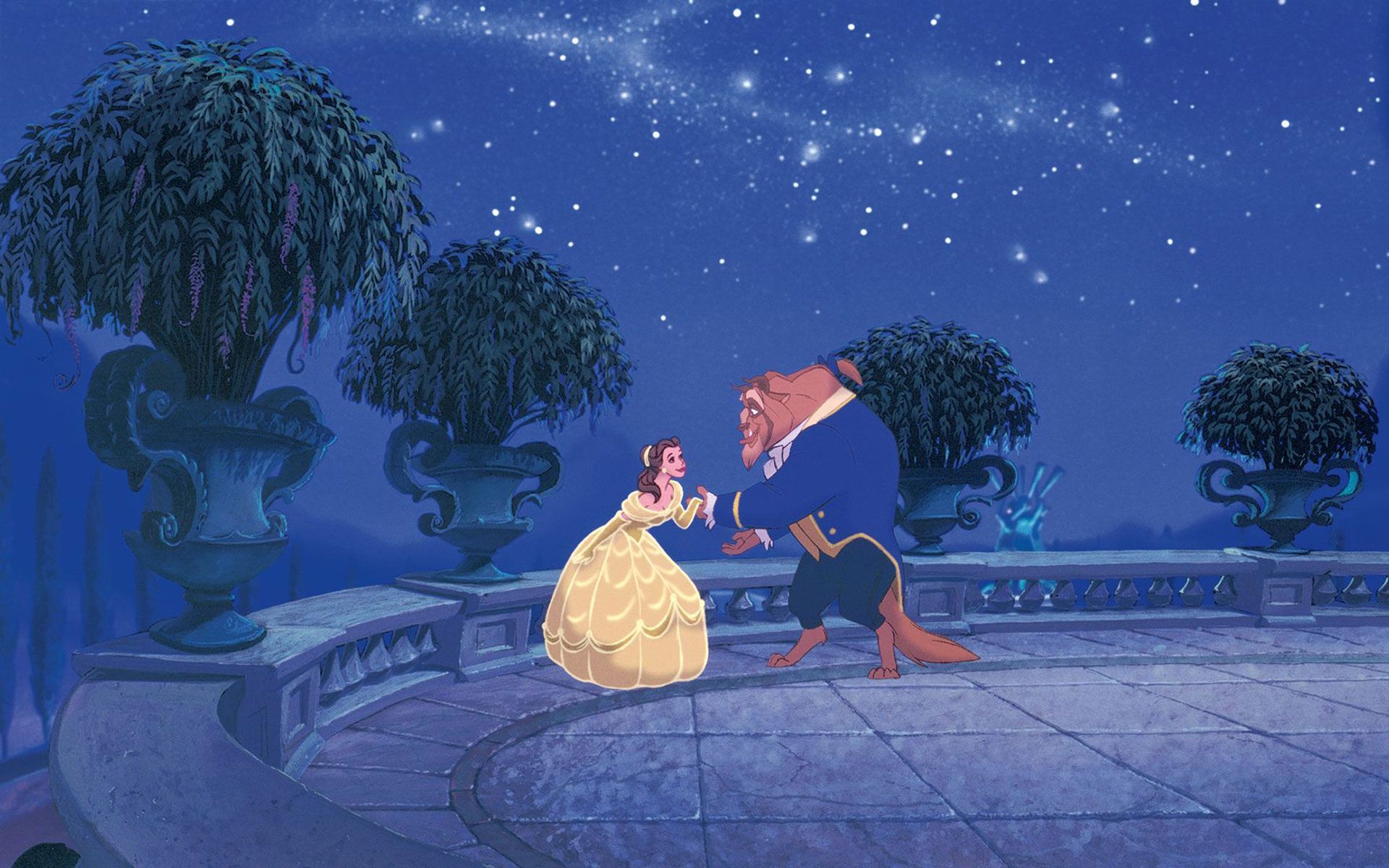No, Beauty and the Beast Does Not Glamourize “Stockholm Syndrome” (Coming from a Psych Major)
Intro
As with most kids, I grew up with the Disney renaissance movies. Aladdin, The Little Mermaid, The Lion King, and many other Disney films were integral parts of my childhood. However, one film stood out to me the most out of Disney’s iconic works. That was their 1991 masterpiece, Beauty and the Beast. In particular, I loved Belle. She was smart, kind, beautiful, had a desire for adventure, and in general, who I wanted to grow up to be.
But many people’s perception of this film changed in the middle to late 2010’s. It felt like Buzzfeed ruled the internet, and they were not shy to critique some of Disney’s classics. They especially targeted Beauty and the Beast, accusing it of romanticizing Stockholm Syndrome. I mean, he does lock her up in his castle, doesn’t he? I, along with others, turned on Beauty and the Beast and jumped on the Buzzfeed bandwagon. As I grew from an angsty preteen into a college psychology major, I revisited the claims about this movie romanticizing Stockholm syndrome. I asked myself, “How much do these Buzzfeed articles hold up years down the road?” And it turns out, this take aged rather poorly in my opinion. From my newfound perspective, it is clear that this relationship is not Stockholm Syndrome (technically Stockholm Syndrome isn’t a real psychological term but we’ll discuss that further later). On the contrary, it’s actually a beautiful story of love, redemption, and growth.
Still, as I look online, it is clear many people did not have the same perspective shift that I had. Therefore, I took it upon myself to offer my personal opinion on this topic! So before discussing why Beauty and the Beast is not Stockholm Syndrome, let’s talk about the term itself: what even is Stockholm Syndrome?

What is Stockholm Syndrome Anyway?
Stockholm Syndrome is generally defined as forming an attachment with your captor. However, when discussing Stockholm Syndrome in the context of pop culture, this attachment tends to be in a romantic context. One of the most famous examples was from the movie 365 Days, where the main character is kidnapped by a Mafia boss and they fall in love.
However, while it is a popular term online, it is not in the DSM-5. The DSM-5 (or Diagnostic and Statistical Manual of Mental Disorders for the non-psych majors) is what is used by mental health professionals to diagnose different disorders. Stockholm Syndrome gets its name from a bank robbery in Stockholm, Sweden. It is said that the hostages bonded with the captors, refusing to testify against them.
Since Stockholm Syndrome is more of a pop culture thing rather than a real psychological disorder, it can be harmful when thrown around lightly. It can mislead people into believing it is a genuine disorder, leading to a misunderstanding of how trauma and abuse actually happen.
Trauma bonding, on the other hand, is very real and can have devastating effects on the victim. It is the concept of how victims form an extremely unhealthy attachment to their captor. This attachment is formed through the cycle of abuse, where the captor will abuse the person held captive, followed by showing remorse towards the victim, making the victim have hope for change. This vicious cycle is what makes trauma bonding so dangerous, and it also helps to explain why Belle does not experience trauma bonding with the Beast (whose real name is Adam, did you guys know that?).

Why Beauty and the Beast Doesn’t Fit
Belle is Not a Passive Victim
Sometimes I wonder when the last time people who say Beauty and the Beast is Stockholm Syndrome actually saw the movie. And really, I promise I don’t mean that in a snarky way. From the perspective of someone who only remembers the bare bones of the plot from when they were kids, it does sound pretty bad. She is locked up by the castle, and eventually her love for the Beast (it feels weird to call him Adam, I’m just gonna stick to the Beast) is what breaks the spell and sets everyone free. That does sound like Stockholm Syndrome. However, it’s the nuances that really count.
First of all, she chooses to stay in the castle. Her father originally trespassed into his house (albeit by accident), and the Beast therefore locked him up. Once Belle finds her dad, she asks the Beast to trade places with him. The Beast agrees, putting her in the cell and letting her father go. However, he immediately moves her into a nicer bedroom and tells her that he hopes she likes it at the castle. I should probably put right here that while I think the Beast is over-hated as a character, I do not believe he is a good person at the beginning of the movie. That was the movie's intention, and they executed it well. He is aggressive, treats his staff horribly, locks up an old man for being in his living room, and is overall a pretty terrible person.
However, what makes this movie work is that Belle also thinks he is a terrible person, and doesn’t put up with it. When he demands her to eat dinner with him, she very blatantly refuses and chooses to stay in her room while he yells at her through the door. When she later goes into the West Wing (the place where he told her she was not allowed to go), he starts yelling at her and throwing over furniture. The movie is not glamorizing this, and the audience is supposed to fear the Beast at this moment. Belle, understandably, says that she refuses to uphold her promise to stay and leaves the castle.
While she is escaping, she is attacked by wolves and the Beast saves her life. Instead of leaving him to die in the woods, she brings him back to the castle as a way of showing gratitude. It is only after this moment that she begins not to see him as a monster. However, just because she sees his good traits does not mean she falls in love with him. Instead, she begins to see him as a friend (She even states this later in the movie, which is also why the spell does not break).
The Beast Changes
Another reason why this film works is that the Beast changes. As he starts to see the good in Belle, he is inspired to become a better person. She never forces him to change, and he does not do it in the hopes of winning her. He may want that, but as we see later in the film, he is willing to give up a future with her if he thinks it means she’ll be happy.
One of my favorite scenes in the film is him giving her the library. While, no, money and grand gifts do not buy happiness, it is more about the sentiment behind it. She is seen as an outcast for enjoying books and reading, and he is the first person besides her dad to show genuine interest in her passions. Again, his growth is inspired by her goodness, not because he wants something from her in return.

She Only Falls in Love with Him After He Lets Her Go
This is probably the biggest point to bring up regarding this film and romanticizing Stockholm Syndrome. He lets her go! He chooses her happiness over becoming a human again. This shows Belle, and the audience, that he has finally learned the true meaning of love. Like the Bible states, “Love is patient, love is kind. It does not envy, it does not boast, it is not proud. It does not dishonor others, it is not self-seeking, it is not easily angered, it keeps no record of wrongs. Love does not delight in evil but rejoices with the truth.”
Another thing people commonly forget is that Belle only falls in love with him at the end of the movie. It is only after she is given the choice that the spell is broken. She has seen his growth into a selfless, kind person who prioritized her well-being over his own desires. And it is only then that this becomes a love story.
Why Mislabeling Matters
It Dismisses Belle’s Agency as a Character
Belle is one of Disney’s strongest characters. She sees past superficiality, is deeply thoughtful and intelligent, and stands up for herself. By creating this false narrative of her being a passive victim, one is taking away her agency. Instead, Belle should be celebrated for her great writing.
It Distorts Real Conversations About Trauma
While Stockholm Syndrome itself is not a real psychological term, what it represents is very real. Trauma bonding is seen in toxic relationships, trafficking, hostage situations, and many more areas. By falsely representing what real abuse looks like, it can make it harder for victims to be taken seriously.
This Reflects How Internet Culture Can Oversimplify Issues
Now that I’m a bit older, I see how the internet likes to make issues very black and white. However, it’s very important to still have that nuance. I don’t think anyone should be blindly following a belief without doing their own research. That can lead to a bandwagon of hatred towards something that may not deserve it. Instead of criticising this movie, we should be celebrating everything it does correctly.
Psychology is a tough field to be in. It’s not like mathematics where there is typically a right and wrong answer. It is complex because humans are complex. That’s why it’s so important to always aim for accuracy before diagnosing something. Beauty and the Beast is just one example of this.
Personal Reflection
All in all, this movie and I have been on quite a journey together. From thinking Belle’s dress was pretty when I was a kid, to believing this movie promotes Stockholm Syndrome, to seeing it as a beautiful love story, my opinion on this film has also reflected my personal growth.
To Conclude…
If you’re still reading this, you probably already know the conclusion I’ve come to regarding this movie. It is absolutely not Stockholm Syndrome. Belle stayed willingly, left willingly, and fell in love willingly. She did not fix the Beast, the Beast fixed himself. They both grew due to each other's influence, and their relationship at the end is very healthy.
I hope what you got out of this was that sometimes things require a further inspection. Before making a bold opinion, ask yourself, “When was the last time I really looked into this issue? Do I have all the facts?” It is okay to be wrong, and it is even more okay to self reflect.
If anyone has any comments or questions, feel free to let me know! Did I miss anything? I’m always open to having a conversation! Have a lovely rest of your day :)
